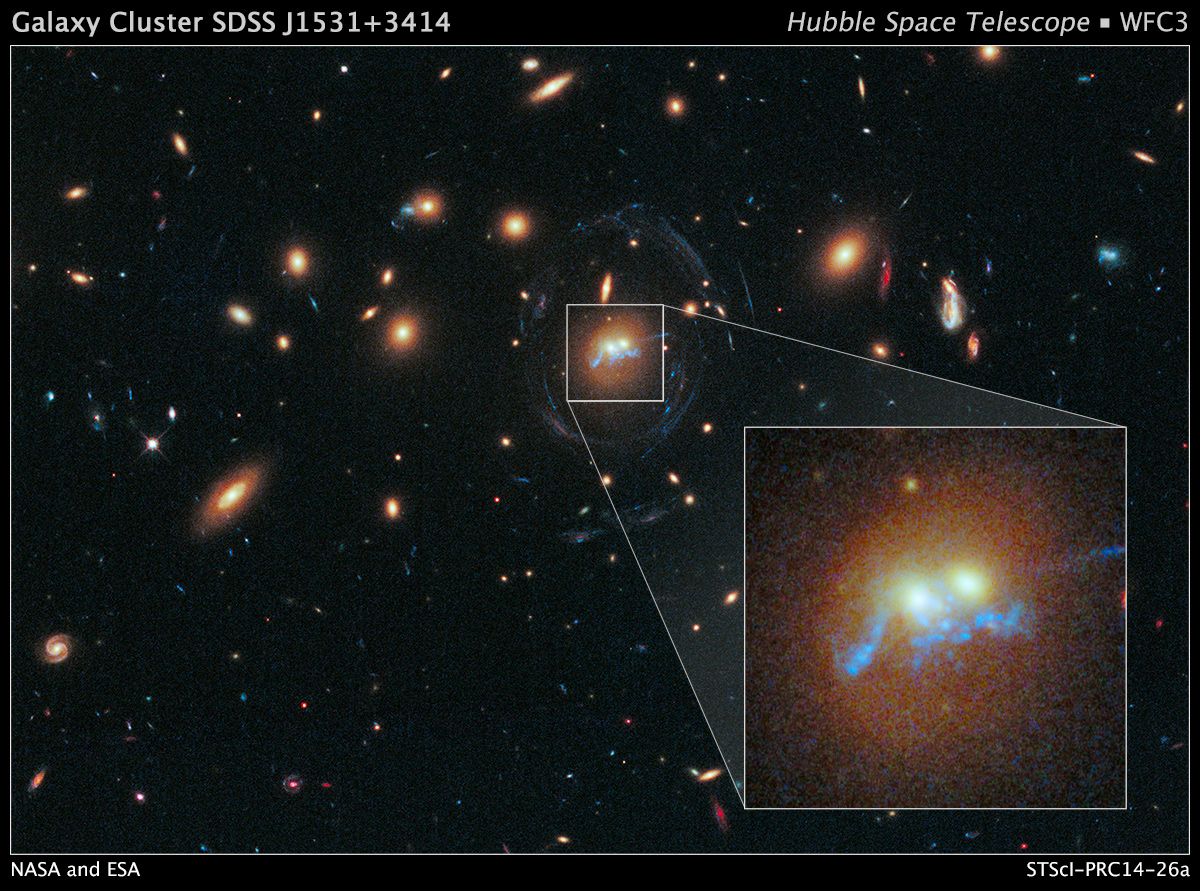Nothing special about that. Except this string is 100,000 light years long.
The pearls in the string are superclusters of blazing, blue-white, newly born stars and the structure forms a bridge between two giant elliptical galaxies that are colliding. These young, blue "super star clusters" are evenly spaced along the chain at separations of 3,000 light-years from one another.
The pair of elliptical galaxies is embedded deep inside the dense galaxy cluster SDSS J1531+3414. The whole assembly, which looks like a tug-of-war, must result from the gravitational tidal forces present in the collision.
Astronomers don't quite know how to explain the origin and ultimate fate of the object, but the answer must be extraordinary.

SDSS J1531+3414. Credit: NASA, ESA, and G. Tremblay/European Southern Observatory
The cluster's powerful gravity warps the image of background galaxies into blue streaks and arcs that give the illusion of being inside the cluster. The first hypothesis was that the "string of pearls" was actually a lensed image from one of these background galaxies, but their recent follow-up observations with the Nordic Optical Telescope definitively rules this out.
If that's not strange enough, the underlying physics behind the "beads on a string" shape is related to describing the behavior of self-gravitating clumps of gas. It's analogous to the process where rain falls in drops rather than in continuous filaments from clouds. It's called the Jeans instability, and it can play out on distance scales of enormous orders of magnitude — from being inches across to many thousands of light-years in length.
"We were surprised to find this stunning morphology, which must be very short-lived" (perhaps about 10 million years, which is a fraction of the time it takes for galaxies to merge), said Grant Tremblay of the European Southern Observatory in Garching, Germany. "We've long known that the 'beads on a string' phenomenon is seen in the arms of spiral galaxies and in tidal bridges between interacting galaxies. However, this particular supercluster arrangement has never been seen before in giant merging elliptical galaxies," he said. "We have two monsters playing tug-of-war with a necklace, and its ultimate fate is an interesting question in the context of the formation of stellar superclusters and the merger-driven growth of a galaxy's stellar component."
The galaxy cluster is part of a Hubble program to look at 23 clusters that are so massive they create powerful gravitational lensing effects on the sky. The clusters were first cataloged in the Sloan Digital Sky Survey. Tremblay's team serendipitously discovered the highly bizarre string of stellar superclusters while reviewing the images as they came in from Hubble. "We were stunned by what we saw in SDSS J1531+3414," Tremblay said. "The uniqueness of this source spurred follow-up observations with both ground- and space-based telescopes."
"This is a beautiful demonstration of the profound scale-invariance of the fundamental laws of nature," Tremblay added. The underlying physical processes that give rise to the "beads on a string" morphology are related to the Jeans instability, describing the behavior of self-gravitating clumps of gas. It's analogous to the process that causes a falling column of water to disrupt, explaining why rain falls in drops rather than in continuous filaments from clouds. Water coming out of the kitchen tap eventually breaks into a series of droplets, and a very similar process is happening in SDSS J1531+3414. "We see the same physics on 100,000-light-year scales that we see in our kitchen sinks and inkjet printers," said Tremblay.
Scientists are currently working on a better understanding of the origin of the chain. One possibility is that the cold molecular gas fueling the burst of star formation may have been native to the two merging galaxies. Another possibility is a so-called "cooling flow" scenario, where gas cools from the ultra-hot (10 million degree) atmosphere of plasma that surrounds the galaxies, forming pools of cold molecular gas that starts to form stars. The third possibility is that the cold gas fueling the chain of star formation originates from a high-temperature shock wave created when the two giant elliptical galaxies crash together. This collision compresses the gas and creates a sheet of dense, cooling plasma.
"Whatever the origin for this star-forming gas is, the result is awesome. It's very exciting. You can't find a mundane explanation for this," Tremblay said.
Sure we can. Go home, cosmology, you're drunk again.
Source: HubbleSite.org






Comments